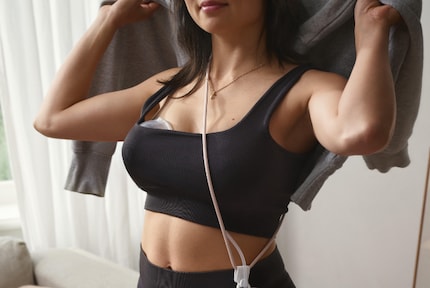
Product test
The hands-free double breast pump from Avent delivers
by Stephan Lamprecht

I spoke to midwife Maike Wentz about the benefits of breast milk, common nursing issues and how a breast pump can make everyday life easier for mothers.
Maike has been a midwife for 36 years and has plenty of experience. On her website and Insta, she shares her knowledge and tests gadgets and gear such as baby carriers.
I got in touch with Maike to talk about breast milk and nursing. After a friend put a breast pump to the test, I want to learn more about the subject.
If you type «breast milk» into a search engine, you’ll be flooded with hits. It appears to be one of the most thoroughly researched aspects of human biology.
Maike, what would you say makes breast milk so special?
First of all, it’s obviously the nutrients. But other facts are far more fascinating. For example, that no «meal» is the same. Just like breastfeeding mothers eat different foods for breakfast, lunch and dinner, the composition of breast milk varies. What’s more, new things are constantly being discovered about its content.
Such as?
Breast milk is different depending on whether the child’s a boy or a girl. If the baby’s a boy, the milk’s higher in protein and fat. It seems that nature’s already laying the foundation for muscle mass, which is somewhat larger in men. If the mum’s ill, the composition of the milk also changes. What happens is that antibodies are transferred to the child so that it doesn’t get sick, too.

Is nursing also beneficial for mothers?
Absolutely. It’s been statistically proven that mothers who breastfed their children are better protected against certain types of cancer, such as breast, ovarian or fallopian tube cancer. It seems that this protective effect increases in long-term breastfeeding mothers. There’s also another positive effect. Oxytocin is released during breastfeeding. That’s the hormone that’s also referred to as the social hormone, cuddle hormone or love hormone. In other words, it helps mothers to bond with their babies and also means that breastfeeding mothers are less likely to suffer from postpartum depression.
I start to get the feeling I could talk to Maike about this topic for hours. Despite all the findings, I get the impression breast milk hasn’t been fully researched. It’s the positive effects that make expectant mums want to nurse their child. However, this decision often goes hand in hand with insecurities, as Maike knows from experience.
Maike, what advice would you give mothers who’re worried that breastfeeding won’t work that they won’t manage to make it part of their daily routine?
It’s always good to get informed beforehand. I’d also advise attending a lactation course. They’re great for learning the basics, such as how to help your baby latch properly. In my experience, how the the mothers are instructed really depends on the hospital. Sadly, due to cutbacks, staff often only have very little time to share their knowledge. But mums can find lots of information in books and online. There’s an abundance of information out there, but this can also create more insecurity. That’s why I always tell «my» mums to trust their instincts. We’re mammals and our bodies are made for nursing. It’s a natural process we can trust. The role of your partner is also very important.
How so?
Things are much easier if you have a partner who has your back and is supportive. But if your partner’s sowing seeds of doubt along the lines of «Your milk isn’t enough», «The baby’s been crying so much, let’s give her formula» or «Why are you putting yourself through all this stress?», then things can be difficult. People who’re close to you should be pulling in the same direction.

Could you give us an example of what the basics are?
Every woman who starts breastfeeding has to overcome certain obstacles. What’s important to know is that nursing can be painful at the beginning. Many people think breastfeeding is wonderful. And it is, but, unfortunately, not always right at the start. This leaves many mums outraged or shocked. That’s when I say that it’s totally normal and will take a little patience. Getting the baby to latch on properly is part of the process. It’s very important that the baby’s mouth covers not just the nipple but part of the areola, too. And then there are various breastfeeding positions to try out, depending on your breasts. There’s no universal position that works for all women.

But even with a supportive partner, there may be situations in which direct breastfeeding isn’t possible or desired. This is where breast pumps comes into play. They’ve become an important gadget for many families.
When is it worth getting a breast pump?
There are many situations where it can come in handy. The most common one is probably when the mother goes back to work. But also if she wants a night out or needs a bit of me-time. A breast pump equals flexibility. A pump can also help mothers who’re struggling to breastfeed. For example, if the baby isn’t sucking properly or her nipples are very sore. Pumping the milk instead will ensure that the infant still gets the nutritious milk.
Are there different types of pumps?
Yes, there are many. For starters, there are manual and electric pumps. The electric pumps are available as single or double pumps. Double pumps are time-saving because both breasts can be pumped at the same time. And then there are hands-free pumps, which really are a game changer.
What makes them so special?
While you’re pumping, you can do something else at the same time: work on your laptop, read a book or look after your child, for example. This type of pump is placed directly inside your bra, leaving your hands free. This is a huge plus, especially for mums who need to pump regularly. In other words, you’re no longer tied to the sofa, killing time until the pumping’s over.
So the pump puts your milk in a bottle. And with the right preparation, this should be a pretty straightforward affair, says Maike. Unless it’s medically necessary, her rule of thumb is to only start using a bottle and pump once the baby’s seven weeks old or older. During this time, babies should learn that their main source of food is the breast.
If parents introduce a bottle earlier, you said they might not be doing themselves a favour. What do you mean?
Well, some children, let’s call them piranhas, don’t care either way. They’re just happy when there’s food. However, drinking from a bottle takes a lot less effort, so babies who are on the sluggish side will catch on to this. They’ll realise that bottles are so much easier to drink from and might reject their mum’s breasts as a consequence.

What about the opposite? Is there a risk of introducing the bottle too late?
Yes, that can also be the case. There are babies who become so breast-fixated that they won’t accept a bottle. After all, it does feel totally different.
Any tips for an easy transition?
Keep in mind that the first few times drinking from a bottle will be stressful for your little one. It’ll be hungry and faced with a change. That’s why it’s often easier if your partner starts the bottle-feeding, as they’re not the usual source of food. Or you could try introducing 30 or 40 millilitres of milk once or twice a week, even if there’s no necessity yet. The main goal is to get your child used to different sensations.
So if dad’s feeding the baby with a bottle for the first time, mum should probably leave the room?
Exactly, otherwise this could cause stress. In my experience, children are more open to change when mum isn’t around. Just like us, kids also like routines. If they’re stressed because they’re hungry or tired, it’ll be very tough to introduce a change.
As a dad, I’d like to know how to go about bottle-feeding. Although my kids are grown up now, I’m curious to hear if I got it right. Maike gave me a few practical tips.
Are there any special techniques parents should follow when giving a bottle?
There are several, yes. Take the position of the bottle, for example. I often see parents holding it at a steep angle, almost vertically. That’s not great because it makes the baby drink too fast. The bottle should only be tilted so far that the teat’s filled with milk. And then there’s a thing called paced bottle feeding. In other words, taking short breaks to avoid the child drinking too quickly. This is actually quite an important, but little-known trick.
At the end of our conversation, I ask Maike for her top tip for parents in the throes of breastfeeding.
What’s the best piece of advice you have?
I believe the most important thing is to believe in yourself. Trust your body and yourself that you’re capable of nursing. What’s also good to know is that there are many ways of breastfeeding. What I mean by that is that you can exclusively breastfeed, breastfeed and pump, pump only or breastfeed after a little pre-feed. There are many options and your current situation to consider.
Our range includes the hands-free pumps from Avent I reviewed a while back:
Hamburg local, bookworm, and ice hockey fan. Dad and granddad. Constantly tinkering around with my smart home setup. I love DIY, the outdoors, fashion, and cosmetics.
Interesting facts about products, behind-the-scenes looks at manufacturers and deep-dives on interesting people.
Show all